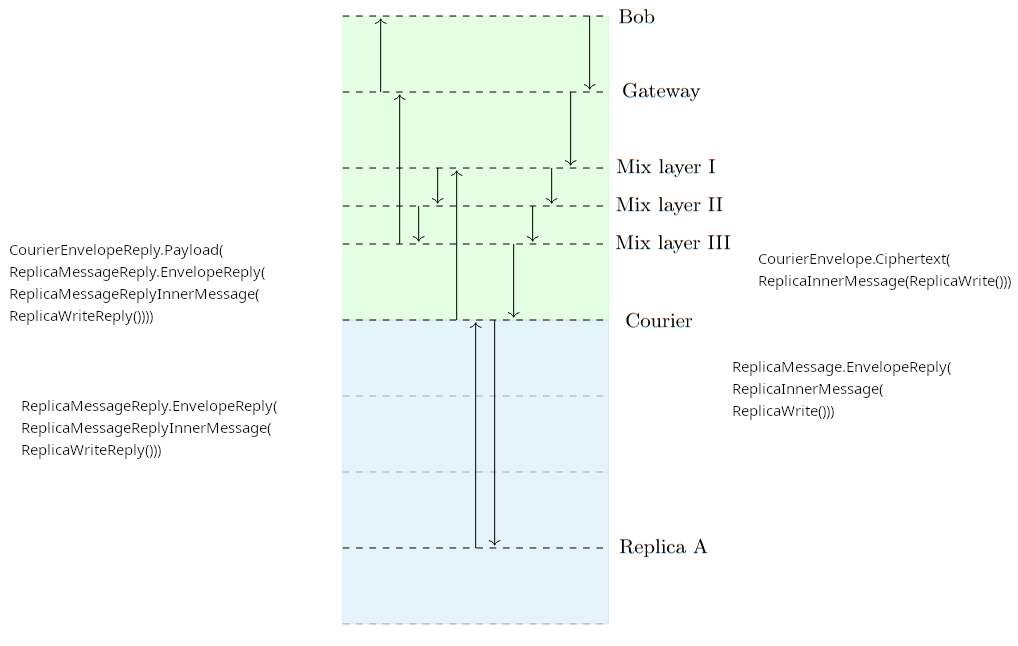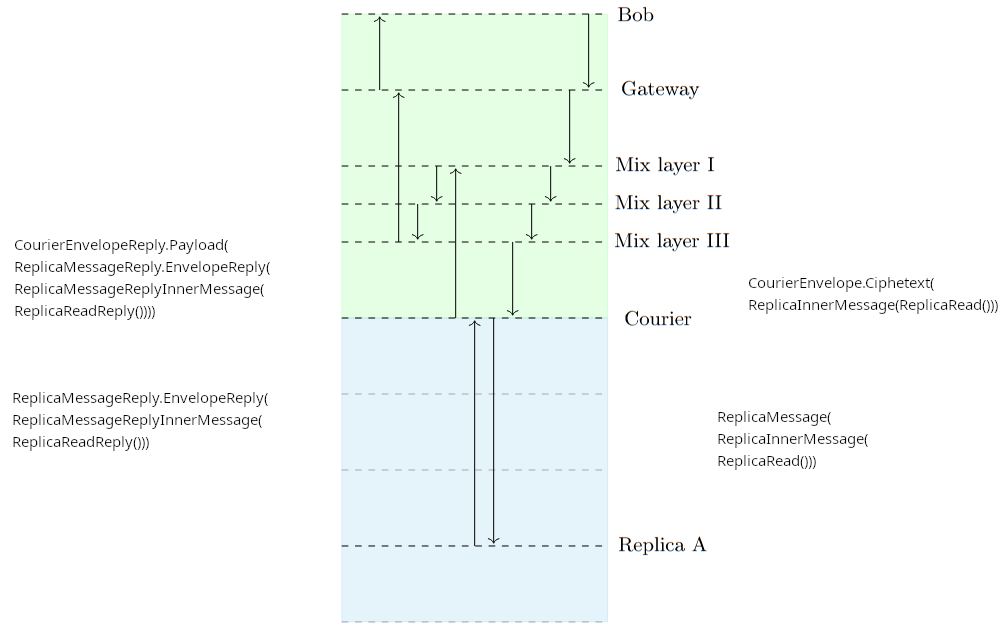AB96
Anderson, R., Biham, E., “Two Practical and Provably Secure Block Ciphers: BEAR and LION”, 1996.
AEZV5
Hoang, V., Krovetz, T., Rogaway, P., “AEZ v5: Authenticated Encryption by Enciphering”, March 2017,
http://web.cs.ucdavis.edu/~rogaway/aez/aez.pdf.
BRIDGING
Danezis, G., Syverson, P., “Bridging and Fingerprinting: Epistemic Attacks
on Route Selection”, Proceedings of PETS 2008, Leuven, Belgium,
July 2008, https://www.freehaven.net/anonbib/cache/danezis-pet2008.pdf.
COMPULS05
Danezis, G., Clulow, J., “Compulsion Resistant Anonymous Communications”,
Proceedings of Information Hiding Workshop, June 2005,
https://www.freehaven.net/anonbib/cache/ih05-danezisclulow.pdf.
ED25519
https://www.rfc-editor.org/rfc/rfc8032.
FINGERPRINTING
Danezis, G., Clayton, R., “Route Finger printing in Anonymous
Communications”,
https://www.cl.cam.ac.uk/~rnc1/anonroute.pdf.
KATZMIXNET
Angel, Y., Danezis, G., Diaz, C., Piotrowska, A., Stainton, D., “Katzenpost
Mix Network Specification”, June 2017,
https://katzenpost.network/docs/specs/pdf/mixnet.pdf.
KATZMIXPKI
Angel, Y., Piotrowska, A., Stainton, D., “Katzenpost Mix Network Public Key Infrastructure Specification”, December 2017, https://katzenpost.network/docs/specs/pdf/pki.pdf.
KATZMIXWIRE
Angel, Y., “Katzenpost Mix Network Wire Protocol Specification”, June 2017,
https://katzenpost.network/docs/specs/pdf/wire.pdf.
KEMCOMB
Federico Giacon, Felix Heuer, Bertram Poettering, “KEM Combiners”, 2018,
https://link.springer.com/chapter/10.1007/978-3-319-76578-5_7
LOCALVIEW
Gogolewski, M., Klonowski, M., Kutylowsky, M., “Local View Attack on
Anonymous Communication”,
https://cs.pwr.edu.pl/kutylowski/articles/LocalView-WWW.pdf.
LOOPIX
Piotrowska, A., Hayes, J., Elahi, T., Meiser, S., Danezis, G., “The Loopix Anonymity System”USENIX, August 2017,
https://arxiv.org/pdf/1703.00536.pdf.
MIRANDA
Leibowitz, H., Piotrowska, A., Danezis, G., Herzberg, A., “No right
to ramain silent: Isolating Malicious Mixes”, 2017,
https://eprint.iacr.org/2017/1000.pdf.
MIXMINION
Danezis, G., Dingledine, R., Mathewson, N., “Mixminion: Design of a
Type III Anonymous Remailer Protocol”,
https://www.mixminion.net/minion-design.pdf.
MIXMINIONDIRAUTH
Danezis, G., Dingledine, R., Mathewson, N., “Type III (Mixminion) Mix
Directory Specification”, December 2005,
https://www.mixminion.net/dir-spec.txt.
MIXRELIABLE
Dingledine, R., Freedman, M., Hopwood, D., Molnar, D., “A Reputation
System to Increase MIX-Net Reliability”, 2001, Information Hiding, 4th
International Workshop,
https://www.freehaven.net/anonbib/cache/mix-acc.pdf.
MIXTOPO10
Diaz, C., Murdoch, S., Troncoso, C., “Impact of Network Topology on
Anonymity and Overhead in Low-Latency Anonymity Networks”, PETS, July
2010, https://www.esat.kuleuven.be/cosic/publications/article-1230.pdf.
MPRA11
Maines, L., Piva, M., Rimoldi, A., Sala, M., “On the provable security of BEAR and LION schemes”, May 2011, arXiv:1105.0259,
https://arxiv.org/abs/1105.0259.
NOISE
Perrin, T., “The Noise Protocol Framework”, May 2017,
https://noiseprotocol.org/noise.pdf.
NOISEHFS
Weatherley, R., “Noise Extension: Hybrid Forward Secrecy”,
https://github.com/noiseprotocol/noise_hfs_spec/blob/master/output/noise_hfs.pdf.
PEERFLOW
Johnson, A., Jansen, R., Segal, A., Syverson, P., “PeerFlow: Secure Load
Balancing in Tor”, July 2017, Proceedings on Privacy Enhancing Technologies,
https://petsymposium.org/2017/papers/issue2/paper12-2017-2-source.pdf.
PQNOISE
Yawning Angel, Benjamin Dowling, Andreas Hόlsing, Peter Schwabe and Florian Weber,
“Post Quantum Noise”, September 2023,
https://eprint.iacr.org/2022/539.pdf.
RFC2119
Bradner, S., “Key words for use in RFCs to Indicate Requirement
Levels”, BCP 14, RFC 2119, DOI 10.17487/RFC2119, March 1997, http://www.rfc-editor.org/info/rfc2119.
RFC5246
Dierks, T. and E. Rescorla, “The Transport Layer Security (TLS) Protocol
Version 1.2”, RFC 5246, DOI 10.17487/RFC5246, August 2008, http://www.rfc-editor.org/info/rfc5246.
RFC5322
Resnick, P., Ed., “Internet Message Format”, RFC 5322, DOI 10.17487/RFC5322, October 2008, https://www.rfc-editor.org/info/rfc5322.
RFC6234
Eastlake 3rd, D. and T. Hansen, “US Secure Hash Algorithms (SHA and SHA-based HMAC and HKDF)”, RFC 6234, DOI 10.17487/RFC6234, May 2011,
https://www.rfc-editor.org/info/rfc6234.
RFC7049
C. Bormannm, P. Hoffman, “Concise Binary Object Representation (CBOR)”, Internet Engineering Task Force (IETF), October 2013,
https://www.rfc-editor.org/info/rfc7049.
RFC7515
Jones, M., Bradley, J., Sakimura, N., “JSON Web Signature (JWS)”, May 2015,
https://www.rfc-editor.org/info/rfc7515.
RFC7539
Nir, Y. and A. Langley, “ChaCha20 and Poly1305 for IETF Protocols”, May 2015, RFC 7539, DOI 10.17487/RFC7539,
http://www.rfc-editor.org/info/rfc7539.
RFC7693
Saarinen, M-J., Ed., and J-P. Aumasson, “The BLAKE2 Cryptographic Hash and Message Authentication Code (MAC)”, RFC 7693, DOI 10.17487/RFC7693, November 2015,
http://www.rfc-editor.org/info/rfc7693.
RFC7748
Langley, A., Hamburg, M., and S. Turner, “Elliptic Curves for Security”, RFC 7748, January 2016,
https://www.rfc-editor.org/info/rfc7748.
SECNOTSEP
Miller, M., Tulloh, B., Shapiro, J., “The Structure of Authority: Why
Security Is not a Separable Concer”,
http://www.erights.org/talks/no-sep/secnotsep.pdf.
SEDA
Welsh, M., Culler, D., Brewer, E., “SEDA: An Architecture
for Well-Conditioned, Scalable Internet Services”, 2001, ACM
Symposium on Operating Systems Principles,
http://www.sosp.org/2001/papers/welsh.pdf.
SFMIX03
Danezis, G., “Forward Secure Mixes”, Proceedings of 7th Nordic
Workshop on Secure IT Systems, 2002, https://www.freehaven.net/anonbib/cache/Dan:SFMix03.pdf.
SP80038A
Dworkin, M., “Recommendation for Block Cipher Modes of Operation”, SP800-38A, 10.6028/NIST.SP.800, December 2001,
https://doi.org/10.6028/NIST.SP.800-38A.
SPHINCS256
Bernstein, D., Hopwood, D., Hulsing, A., Lange, T., Niederhagen, R., Papachristodoulou,
L., Schwabe, P., Wilcox O'Hearn, Z.,
“SPHINCS: practical stateless hash-based signatures”,
http://sphincs.cr.yp.to/sphincs-20141001.pdf.
SPHINX09
Danezis, G., Goldberg, I., “Sphinx: A Compact and Provably Secure Mix
Format”, DOI 10.1109/SP.2009.15, May 2009, https://cypherpunks.ca/~iang/pubs/Sphinx_Oakland09.pdf.
SPHINXSPEC
Angel, Y., Danezis, G., Diaz, C., Piotrowska, A., Stainton, D., “Sphinx Mix Network Cryptographic Packet Format Specification”, July 2017,
https://katzenpost.network/docs/specs/pdf/sphinx.pdf.
TORDIRAUTH
“Tor directory protocol, version 3”,
https://spec.torproject.org/dir-spec/index.html.
TORSRV
“Tor Shared Random Subsystem Specification”,
https://spec.torproject.org/srv-spec/index.html.
XWING
Manuel Barbosa, Deirdre Connolly, Joγo Diogo Duarte, Aaron Kaiser, Peter Schwabe,
Karoline Varner, Bas Westerbaan, “X-Wing: The Hybrid KEM You’ve Been Looking
For”,
https://eprint.iacr.org/2024/039.pdf.
![[Note]](file:/home/usr/local/Oxygen%20XML%20Editor%2027/frameworks/docbook/css/img/note.png)


